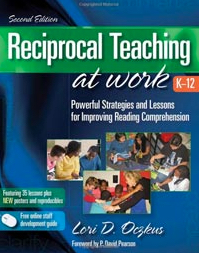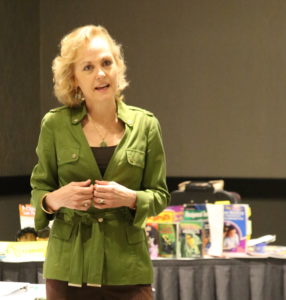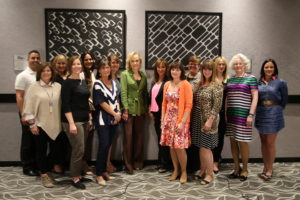When it comes to reading…comprehension is everything. And yet, many students struggle to really understand the texts they read.
 In 2009, the National Assessment of Educational Progress—better known as ‘The Nation’s Report Card,’—found that a staggering 70% of eighth graders and nearly as many fourth graders read below proficiency levels. The national test, which began in the early 1970s and has been conducted every two years since the mid-1990s, has shown some improvements in reading scores since 2009, but reading comprehension levels still remain a concern for educators across the country.
In 2009, the National Assessment of Educational Progress—better known as ‘The Nation’s Report Card,’—found that a staggering 70% of eighth graders and nearly as many fourth graders read below proficiency levels. The national test, which began in the early 1970s and has been conducted every two years since the mid-1990s, has shown some improvements in reading scores since 2009, but reading comprehension levels still remain a concern for educators across the country.
To read the most recent results from 2015 and learn about test result trends since the mid-1990s, click here: http://www.nationsreportcard.gov/reading_math_2015/#?grade=4
But solid techniques, backed by research, do exist to help students with comprehension.
In the mid-1980s, two researchers at the University of Illinois, Annemarie Palinscar and Ann Brown, worked with middle school students and found that while they were adept at decoding words, they struggled with comprehension. Palinscar and Brown developed an approach to provide explicit instruction for students to effectively tackle comprehension. The approach, called “Reciprocal Teaching,” set out four clear steps for teachers to guide students while reading texts: predict, question, clarify and summarize.
You can read Palinscar and Brown’s 1984 paper on Reciprocal Teaching, here: http://tinyurl.com/gqcacup
By using these techniques three times a week in her Berkeley classroom, Lori found that struggling students were reading at 1-2 grades higher in just three months.
Palinscar and Brown found that students who were guided through their reading with these explicit instructions, bolstered by cooperative classroom discussion, made great strides in their comprehension. Moreover, the techniques of Reciprocal Teaching also helped struggling readers, as well as ELL students.
Other researchers over the years have conducted additional studies to replicate and expand on Palinscar and Brown’s work. To read more, check out this 1993 review of the research at the University of Illinois’ Center for the Study of Reading: http://tinyurl.com/h2xy8lz

Lori Oczkus, author of “Reciprocal Teaching at Work,” presenting to IMSE instructors at the company’s 2015 conference
Educator Lori Oczkus discovered the power of Reciprocal Teaching in her own classrooms as a teacher and reading specialist working in an inner-city school in Berkeley, California. In 2004, she published “Reciprocal Teaching at Work,” in an effort to bring the practical steps of this approach to a wider audience. Since then, her book is in its second edition (with a third on the way!) and Lori has traveled throughout the U.S. and the world, working with students and teachers to make the powerful techniques of Reciprocal Teaching part of their classrooms.
The 2nd Edition of “Reciprocal Teaching at Work” is available through the IMSE store, here: https://www.orton-gillingham.com/products/271/

IMSE instructors and Lori Oczkus
In April of this year, Lori presented to IMSE instructors over two days at the company’s annual conference in Michigan.
The Journal sat down with Lori to learn more about what she calls the ‘Fab Four’ techniques of Reciprocal Teaching and about the findings of the researchers who developed this method.
In part II of our talk, Lori describes the underlying foundations of Reciprocal Teaching. Among those key foundations are scaffolded instruction and metacognition.
Both scaffolded instruction and metacognition have their roots in cognitive and developmental psychology going back several years.
In scaffolded instruction, teachers lead students at the outset of instruction, often with prompts, and support them through increasingly more complex material, while gradually leading them toward independently taking on tasks.
Cognitive psychologist Jerome Bruner is often credited with coining the term, ‘scaffolding’ in education. In a 1978 paper, Bruner stated that scaffolding, “refers to the steps taken to reduce the degrees of freedom in carrying out some task so that the child can concentrate on the difficult skill she is in the process of acquiring.” Bruner’s contributions to the fields of psychology and education are many, perhaps his largest is that learning is an active process whereby students work at making—or constructing—meaning. This school of thought came to be known as ‘constructivist theory.’
To watch Dr. Bruner discuss the impact of teaching on learning in this 2014 YouTube interview, click here: https://www.youtube.com/watch?v=aljvAuXqhds
Metacognition calls on students to not only follow, for example, the ‘Fab Four’ steps of Reciprocal Teaching, but to actively think about why these steps are important, how they help readers to better understand texts and get students to self-monitor their own thinking to hone in on material that might be confusing to them. Put more simply: metacognition is thinking about thinking.
Ann Brown and developmental psychologist John Flavell were among the researchers who began delving into the function and utility of metacognition in learning during the late 1970s and early 1980s. Brown later worked with Annemarie Palinscar to integrate metacognition into Reciprocal Teaching. In 1990, Ann Brown was part of a National Research Council Committee that argued for an active cultivation of metacognition in education environments in their book, “How People Learn.”
To learn more about the study metacognition, check out: https://cft.vanderbilt.edu/guides-sub-pages/metacognition/
“How People Learn” is available online, here: http://www.nap.edu/read/9853/chapter/1
In part III, Lori talks about the best practices of Reciprocal Teaching. Like most things…practice makes perfect! Lori recommends that teachers use these techniques in the classroom at least twice a week. Lori also discusses how to further develop students’ work with the Fab Four.
Teachers will also find that Reciprocal Teaching can be used with any kind of text—from fiction to some of the more challenging non-fiction passages that now appear as part of Common Core testing—students can always apply the Fab Four to their reading.
When it comes to the gains students can make with Reciprocal Teaching, Lori says,”The results are consistent and dramatic when teachers use this strategy.” By using these techniques three times a week in her Berkeley classroom, Lori found that struggling students were reading at 1-2 grades higher in just three months.
Finally, Lori talks about the profound changes that can occur with struggling students and Reciprocal Teaching. “I see that it’s a confidence builder,” Lori says. “It’s something that students pick up on and all of the sudden, they start to take off. Students that we’ve never heard from before, within a week or two of using it in the classroom will start to raise their hand.”
For more about Reciprocal Teaching, its techniques and ideas on how to use it in your classroom, check out Lori Oczkus’ web site: http://www.lorioczkus.com/teachers-tips-lori-oczkus.php
